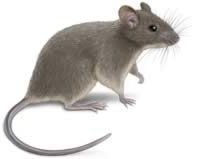Tell Tale Signs You Have A Mouse In The House
House Mouse

The house mouse is considered one of the most troublesome rodents in the United States. House mice thrive under a variety of conditions. They are found in and around homes and farms as well as in open fields and agricultural lands. House mice consume and contaminate food meant for humans, livestock, or other animals. They cause damage to structures and property, and they transmit diseases such as salmonellosis and swine dysentery.
Recognizing Mouse Infestations
Droppings, fresh gnaw marks and tracks indicate areas where mice are active. Mouse nests, made from fine shredded paper or other fibrous material, often are found in sheltered locations. House mice have a characteristic musky odor that identifies their presence. Mice are active mostly at night, but can be seen occasionally during daylight hours.
House Mouse Facts
House mice are small rodents with relatively large ears and small black eyes. They weigh about 1/2 ounce and usually are light gray in color. An adult is about 5 1/2 to 7 1/2 inches long, including the 3- to 4-inch tail.
Although house mice usually feed on cereal grains, they will eat almost anything. They are sporadic feeders, nibbling bits of food here and there.
Mice have keen senses of hearing, smell, taste and touch. They are excellent climbers and can run up any rough vertical surface. They will run horizontally along wire cables or ropes and can jump up 12 inches from the floor onto a flat surface. Mice can squeeze through openings slightly larger than 1/4 inch in diameter.
In a single year, a female may have five to 10 litters of usually five or six young each. Young are born 19 to 21 days after mating, and they reach reproductive maturity in six to 10 weeks. The life span of a mouse is usually nine to 12 months.